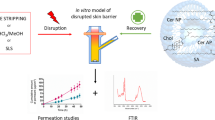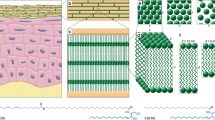Abstract
We previously showed that topical application of hexoses such as fructose accelerates barrier recovery after disruption. We also showed that various hexoses and polyols interact with phospholipid and alter the phase transition temperature. Thus, we hypothesized that the improvement of barrier recovery by hexoses and polyols might be related to the interaction with phospholipid. Here, we tested this idea by examining the effects of xylitol (a component of some skin-care products) and fructose on lipid dynamics in an epidermal-equivalent model at the single-cell level by means of two-photon microscopy after staining with Laurdan, a fluorescent dye sensitive to the physical properties of its membrane environment. First, we confirmed that topical application of xylitol aqueous solution on tape-stripped human skin accelerated barrier recovery. Then, we examined changes of lipid fluidity in the epidermal-equivalent model after application of water or an aqueous solution of xylitol or fructose. Application of xylitol and/or fructose increased the lipid fluidity in the uppermost part of the stratum granulosum layer, compared to treatment with water alone, and accelerated the exocytosis of lamellar bodies to the intercellular domain between stratum corneum and stratum granulosum. Our results support the idea that the improvement of epidermal barrier homeostasis upon topical application of xylitol or fructose is due to increased lipid fluidity in the uppermost layer of the stratum granulosum, which enables accelerated release of lipid from the stratum granulosum, thereby improving the lamellar structure and accelerating epidermal permeability barrier recovery.







Similar content being viewed by others
References
Denda M (2011) Effects of topical application of aqueous solutions of hexoses on epidermal permeability barrier recovery rate after barrier disruption. Exp Dermatol 20:943–944
Denda M, Fuziwara S, Inoue K (2003) Influx of calcium and chloride ions into epidermal keratinocytes regulates exocytosis of epidermal lamellar bodies and skin permeability barrier homeostasis. J Invest Dermatol 121:362–367
Denda M, Fuziwara S, Inoue K (2004) Association of cyclic adenosine monophosphate with permeability barrier homeostasis of murine skin. J Invest Dermatol 122:140–146
Denda M, Kitamura K, Elias PM, Feingold KR (1997) Trans-4-(Aminomethyl)cyclohexane carboxylic acid (T-AMCHA), an anti-fibrinolytic agent, accelerates barrier recovery and prevents the epidermal hyperplasia induced by epidermal injury in hairless mice and humans. J Invest Dermatol 109:84–90
Denda M, Koyama J, Namba R, Horii I (1994) Stratum corneum lipid morphology and transepidermal water loss in normal skin and surfactant-induced scaly skin. Arch Dermatol Res 286:41–46
Denda M, Sato J, Masuda Y, Tsuchiya T, Koyama J, Kuramoto M, Elias PM, Feingold KR (1998) Exposure to a dry environment enhances epidermal permeability barrier function. J Invest Dermatol 111:858–863
den Hollander L, Han H, de Winter M, Svensson L, Masich S, Daneholt B, Norlén L (2016) Skin lamellar bodies are not discrete vesicles but part of a tubuloreticular network. Acta Derm Venereol 96:303–308
Elias PM (2006) The epidermal permeability barrier from Saran Wrap to biosensor. In: Skin B, Elias PM, Feingold KR (eds), 2. Taylor & Francis, New York, pp 25–31
Elias PM, Cullander C, Mauro T, Rassner U, Kömüves L, Brown BE, Menon GK (1998) The secretory granular cell: the outermost granular cell as a specialized secretory cell. J Investig Dermatol Symp Proc 3:87–100
Feingold KR, Elias PM (2014) Role of lipids in the formation and maintenance of the cutaneous permeability barrier. Biochim Biophys Acta 1841:280–294
Kalia YN, Pirot F, Guy RH (1996) Homogeneous transport in a heterogeneous membrane: water diffusion across human stratum corneum in vivo. Biophys J 71:2692–2700
Korponyai C, Szél E, Behány Z, Varga E, Mohos G, Dura Á, Dikstein S, Kemény L, Erős G (2017) Effects of locally applied glycerol and xylitol on the hydration, barrier function and morphological parameters of the skin. Acta Derm Venereol 97:182–187
Kumamoto J, Nakanishi S, Umino Y, Denda M (2018) Removal of nontoxic foreign material to the surface by cultured human epidermal keratinocytes in an epidermal-equivalent model. J Dermatol Sci 89:97–99
Mazeres S, Fereidouni F, Joly E (2017) Using spectral decomposition of the signals from laurdan-derived probes to evaluate the physical state of membranes in live cells. F1000 Res 6:763
Nakata S, Deguchi A, Seki Y, Furuta M, Fukuhara K, Nishihara S, Inoue K, Kumazawa N, Mashiko S, Fujihira S, Goto M, Denda M (2015) Characteristic responses of a phospholipid molecular layer to polyols. Colloid Surf B Biointerfaces 136:594–599
Nakata S, Nomura M, Yamaguchi Y, Hishida M, Kitahata H, Katsumoto Y, Denda M, Kumazawa N (2019) Characteristic responses of a 1,2-dipalmitoleoyl-sn-glycero-3- phosphoethanolamine molecular layer depending on the number of CH(OH) groups in polyols. Colloids Surf A Physicochem Eng Asp 560:149–153
Nakata S, Shiota T, Kumazawa N, Denda M (2012) Interaction between a monosaccharide and a phospholipid molecular layer. Colloids Surf A 405:14–18
Norlén L (2001) Skin barrier formation: the membrane folding model. J Invest Dermatol 117:823–829
Sanchez SA, Tricerri MA, Gratton E (2012) Laurdan generalized polarization fluctuations measures membrane packing micro-heterogeneity in vivo. Proc Natl Acad Sci USA 109:7314–7319
Sato J, Denda M, Nakanishi J, Koyama J (1998) Dry condition affects desquamation of stratum corneum in vivo. J Dermatol Sci 18:163–169
Acknowledgements
We appreciate the feedback offered by Dr. Makiko Goto (Shiseido Global Innovation Center). This work was supported by JST CREST Grant Number JPMJCR15D2, Japan.
Author information
Authors and Affiliations
Corresponding author
Ethics declarations
Conflict of interest
The authors declare that they have no conflict of interest.
Research involving human participants and/or animals
The protocol was approved by the ethics committees of Shiseido Research Center, and was in accordance with the National Institute of Health guideline and Declaration of Helsinki principles.
Informed consent
Informed consent was obtained from all individual participants.
Additional information
Publisher’s Note
Springer Nature remains neutral with regard to jurisdictional claims in published maps and institutional affiliations.
Electronic supplementary material
Below is the link to the electronic supplementary material.
Rights and permissions
About this article
Cite this article
Umino, Y., Ipponjima, S. & Denda, M. Modulation of lipid fluidity likely contributes to the fructose/xylitol-induced acceleration of epidermal permeability barrier recovery. Arch Dermatol Res 311, 317–324 (2019). https://doi.org/10.1007/s00403-019-01905-0
Received:
Revised:
Accepted:
Published:
Issue Date:
DOI: https://doi.org/10.1007/s00403-019-01905-0




